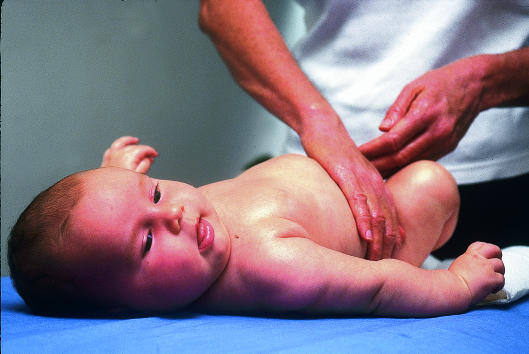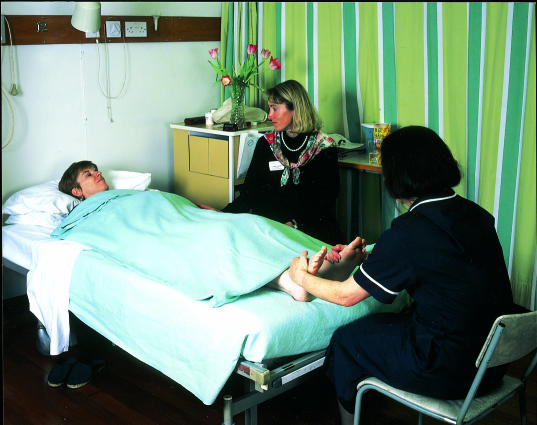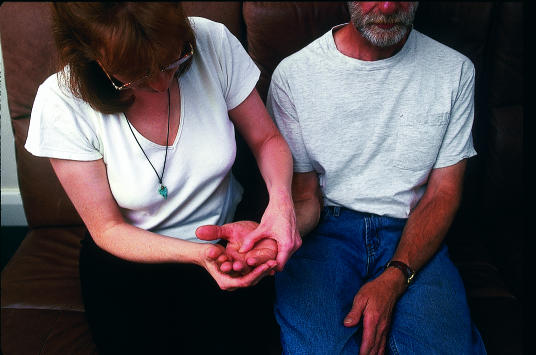Therapeutic massage is the manipulation of the soft tissue of whole body areas to bring about generalised improvements in health, such as relaxation or improved sleep, or specific physical benefits, such as relief of muscular aches and pains.
Background
Almost all cultures have developed systems of therapeutic massage. Massage techniques play an important part in traditional Chinese and Indian medical care. European massage was systematised in the early 18th century by Per Hendrik Ling, who developed what is now known as Swedish massage.
Ling believed that vigorous massage could bring about healing by improving the circulation of the blood and lymph. In the past 20-30 years complementary therapists have adapted Swedish massage so as to place greater emphasis on the psychological and spiritual aspects of treatment. Benefits of massage are now described more in terms such as “calmness” or “wholeness” than in terms of loosening stiff joints or improving blood flow. In contrast to the vigorous and standardised treatment recommended by Ling, current massage techniques are more gentle, calming, flowing, and intuitive.
Examples of other predominantly touch based therapies
| Rolfing Structural integration Hellerwork | Treatments which use deep pressure massage to improve function of muscular system |
| Alexander technique Feldenkrais | Educational systems incorporating exercises and hands-on therapy designed to improve posture, movement, and function |
| Bioenergetics | Massage to aid the psychotherapeutic process |
| “Bodywork” | Any combination of the above |
Several techniques derive from traditions separate from European massage. In reflexology, areas of the foot are believed to correspond to the organs or structures of the body. Damage or disease in an organ is reflected in the corresponding region, or “reflex zone,” of the foot. When this is palpated the patient is said to experience pain or pricking, no matter how gently pressure is applied. Reflexology treatment consists of massage of the disordered reflex zones.
In aromatherapy, oils derived from plants (“essential oils”) are added to a base massage oil, which acts as a lubricant during treatment. Although often used purely for their smell, the oils are claimed to have a wide range of medicinal properties, including effects on wound healing, infection, blood circulation, and digestion. They are said to act both pharmacologically, by absorption into the blood through the skin, and by olfactory stimulation. Many massage practitioners use essential oils without claiming to be practising aromatherapy.
Various other complementary disciplines are primarily touch based or have a substantial touch component (see box).
What happens during a treatment?
Massage treatment takes a variety of forms and may last anywhere between 15 and 90 minutes. Treatment follows a case history, which is usually relatively short compared with other complementary therapies but which varies in length depending on the patient's condition and the indications for massage. While giving a standard massage, practitioners will also gather palpatory information, which helps tailor treatment to individual needs. For example, a practitioner will devote extra time to massage an area of increased muscle tension.
The patient is ideally treated unclothed, on a specially designed massage couch. This normally incorporates soft but firm padding and a hole for the face. The treatment room is kept warm and quiet. Soft music may sometimes be played.
Practitioners generally treat the whole body, using oil to help their hands move over the patient's body. A variety of strokes are used, including effleurage, petrissage, kneading, and friction (see box). Massage practitioners who treat sports injuries and musculoskeletal disorders may incorporate techniques derived from physiotherapy, osteopathy, and chiropractic. These include deep massage, passive and active stretching, and muscle energy techniques (in which the patient moves against resistance from the practitioner).
Techniques used in massage
Effleurage—Gentle stroking along the length of a muscle
Petrissage—Pressure applied across the width of a muscle
Friction—Deep massage applied by circular motions of the thumbs or fingertips
Kneading—Squeezing across the width of a muscle
Hacking—Light slaps or karate chops
Massage can be adapted to the constraints of conventional health settings by limiting work to the head, hands, feet, or back or even by giving a neck and shoulder rub through clothes with the patient sitting in a chair.
Patients usually find massage to be a deeply relaxing and pleasurable experience. Some techniques include strong pressure, which can cause painful sensations, but these are usually short lived.
Therapeutic scope
Massage is mainly used to promote relaxation, treat painful muscular conditions, and reduce anxiety (often described in terms of “relief from stress”). Practitioners also claim to bring about short term improvements in sleep disorders and pain, conditions known to be exacerbated by anxiety, and massage is widely used for these indications.
Massage is also claimed to have more global effects on health. Practitioners and patients report that massage improves self image in conditions such as physical disabilities and terminal illnesses. This may result in part from the feelings of general wellbeing that are commonly reported after massage. Touch itself is likely to be therapeutic, particularly in those with limited opportunities for physical contact, such as patients without intimate friends or family or with painful physical conditions.
Massage has also been said to help patients feel cared for. Patients may be more ready to discuss and deal with difficult psychological issues once they are less anxious, feel better about themselves, and have come to trust their care providers. Practitioners say that this is one of the reasons why massage can be an important stepping stone to effective counselling, for example, in managing mental health problems or addiction.
Massage has been used to foster communication and relationships in several other settings. In work with children with profound disabilities, where touch may be a primary means of communication, massage techniques have been incorporated into the everyday activities of care workers. Similarly, some midwives run “baby massage” groups where new mothers are taught massage as a means of improving their relationship with their children.
Practitioners of reflexology claim that, in addition to the relaxation and non-specific effects of massage, they can bring about more specific changes in health. One classic reflexology text, for example, includes case histories of ataxia, osteoarthritis, and epilepsy. Similarly, some aromatherapists report benefits in conditions as diverse as infertility, acne, diabetes, and hay fever.
Research evidence
To date, most of the clinical trials of massage have focused on psychological outcomes of treatment. Good evidence from randomised trials indicates that massage reduces anxiety scores in the short term in settings as varied as intensive care, psychiatric institutions, hospices, and occupational health. There is more limited evidence that these anxiety reductions are cumulative over time. Practitioners claim that giving patients a concrete experience of relaxation through massage can facilitate their use of self help relaxation techniques. This has yet to be evaluated. The evidence that massage can lead to improved sleep and reduce pain remains anecdotal.
Key studies of efficacy
Systematic review
Vickers A, Ohlsson A, Lacy JB, Horsley A. Massage therapy for premature and/or low birth-weight infants to improve weight gain and/or to decrease hospital length of stay. In: Cochrane Collaboration. The Cochrane Library. Issue 3. Oxford: Update Software, 1998
Randomised controlled trials
Field T, Morrow C, Valdeon C, Larson S, Kuhn C, Schanberg S. Massage reduces anxiety in child and adolescent psychiatric patients. J Am Acad Child Adolesc Psychiatry 1992;31:125-31
Stevensen C. The psychophysiological effects of aromatherapy massage following cardiac surgery. Complement Ther Med 1994; 2:27-35
Wilkinson S. Aromatherapy and massage in palliative care. Int J Palliative Nurs 1995;1:21-30
Some evidence supports the more “traditional” effects of massage such as improved circulation and decreased muscle tension. However, no reliable data link these changes to clinically worthwhile benefits such as relief of musculoskeletal pain, increased mobility, or improved athletic performance.
Randomised trials have provided some evidence that massage in premature infants is associated with objective outcomes such as more rapid weight gain and development. Many other anecdotal benefits of massage are more subtle and have not been subjected to randomised controlled trials.
There are very few clinical trials showing that any massage technique can have specific effects on conditions such as osteoarthritis, epilepsy, infertility, or diabetes. Very few trials have evaluated the relative advantages of different massage techniques.
Safety of massage techniques
Most massage techniques have a low risk of adverse effects. Cases reported in the literature are extremely rare and have usually involved techniques that are unusual in the United Kingdom, such as extremely vigorous massage.
Contraindications to massage are based largely on common sense (for example, avoiding friction on burns or massage in a limb with deep vein thrombosis) rather than empirical data. Massage after myocardial infarction is controversial, although studies have shown that gentle massage is only a moderate physiological stimulus that does not cause undue strain on the heart. There is no evidence that massage in patients with cancer increases metastatic spread, although direct firm pressure over sites of active tumour should generally be avoided.
Considerable concern has been raised about the safety of the oils used in aromatherapy. Although essential oils are pharmacologically active, and in some cases potentially carcinogenic in high concentrations, adverse events directly attributable to them are extremely rare. This may be because in practice the oils are used externally and in low doses (concentrations of 1-3%). However, the lack of a formal reporting scheme for adverse events in aromatherapy means that the safety of essential oils has not been conclusively established.
Massage obviously involves close physical contact. To minimise the risks of unprofessional behaviour in this situation, patients should ensure that practitioners are registered with an appropriate regulatory body.
Practice
Like many complementary therapies, massage is usually practised in private in the community. It is also found in conventional health settings, in particular in hospices and in units for learning disability and mental disorders. Massage in these settings is often practised by nurses or by unpaid practitioner volunteers, and much practice is informal, such as a head and neck rub for a distressed patient. However, an increasing number of professional massage practitioners are now employed in NHS hospitals and general practices.
Regulation
Practitioners of massage therapies are currently registered by many different organisations, a situation that is confusing for those trying to find a reputable practitioner. There are umbrella organisations that attempt to unite the different registering bodies in massage and aromatherapy but not in reflexology. It is probably wise to choose a practitioner from an organisation that is a member association of the British Complementary Medicine Association (BCMA) as these associations are regularly reviewed by the BCMA panel (see earlier article on complementary medicine in practice for contact details of BCMA).
Umbrella organisations involved in registering massage based therapies
British Massage Therapy Council
17 Rymers Lane, Oxford OX4 3JU. Tel: 01865 774123 (for lists of registered practitioners 0181 992 2554). URL: www.bmtc.co.uk
Aromatherapy Organisations Council
PO Box 19834 London SE25 6WF. Tel: 0181 251 7912. Fax: 0181 251 7942. URL: www.aromatherapy-uk.org
Conventional healthcare professionals, who may have undertaken massage training but not have formal qualifications, are regulated by their own professional body.
Training
The variety of training courses is enormous, with many specifically aimed at conventional healthcare workers such as nurses. A central examinations agency, the International Therapy Examinations Council (ITEC), holds examinations in massage and related therapies that are accepted by many organisations. Other courses range from weekend courses in basic massage to university degree courses in therapeutic massage.
Further reading
Vickers A. Massage and aromatherapy: a guide for health professionals. Cheltenham: Stanley Thornes, 1998
Figure.
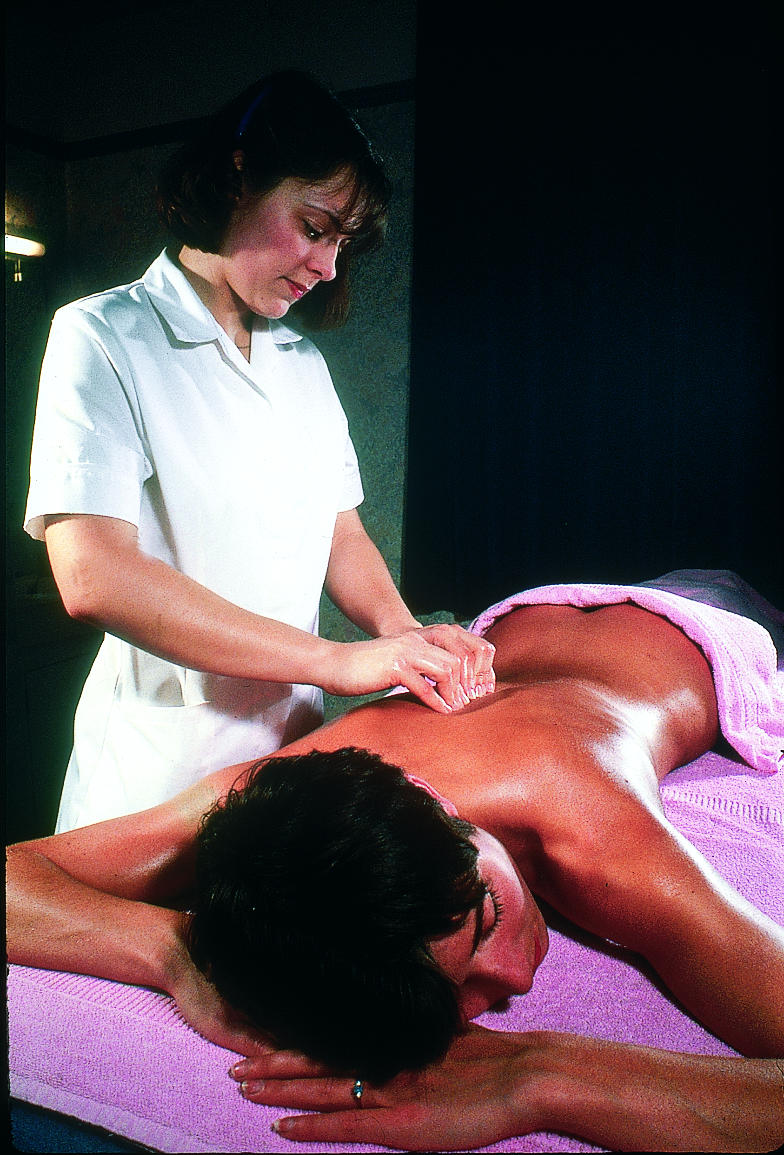
A typical massage treatment session
Figure.
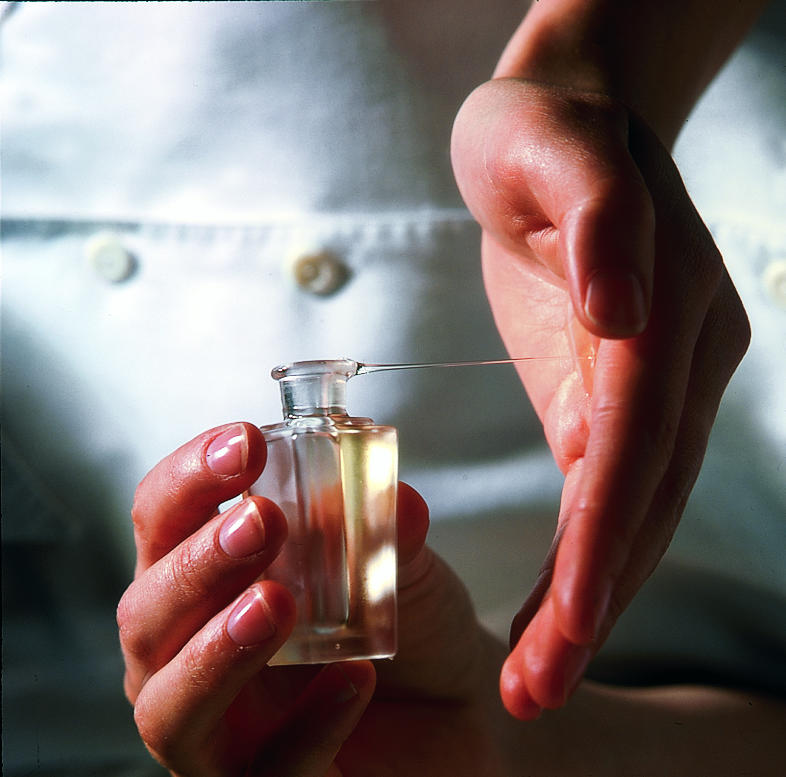
UK massage practitioners usually use an oil, such as sweet almond oil, as a lubricant. Elsewhere in Europe, soap or talcum powder are sometimes used instead
Figure.
Baby massage is one way of encouraging physical interaction and stimulating the developing relationship between parent and child
Figure.
Massage on a hospital ward: foot massage has been shown to reduce anxiety even in highly stressful settings
Figure.

More research is needed on both the therapeutic benefits and the safety implications of using essential oils in massage. However, the doses used are low, and problems seem to be extremely rare
Figure.
If necessary, massage can be adapted to the constraints of conventional healthcare settings by limiting work to the hands, head, or neck and shoulders
Acknowledgments
The pictures of full massage and of massage oil are reproduced with permission of Damien Lovegrove/Science Photo Library. The pictures of baby massage and hand massage are reproduced with permission of BMJ/Ulrike Preuss. The picture of massage in a hospital is reproduced with permission of the Royal London Homoeopathic Hospital. The picture of essential oils is reproduced with permission of Steve Horrell/Science Photo Library.
Footnotes
The ABC of complementary medicine is edited and written by Catherine Zollman and Andrew Vickers. Catherine Zollman is a general practitioner in Bristol, and Andrew Vickers will shortly take up a post at Memorial Sloan-Kettering Cancer Center, New York. At the time of writing, both worked for the Research Council for Complementary Medicine, London. The series will be published as a book in Spring 2000.



